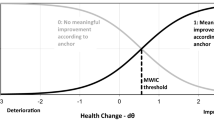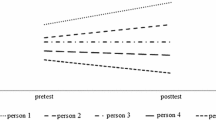Abstract
Background
Studies on how to better measure change have been published at least since the third decade of the last century, but no general indicator or strategy of measurement is currently agreed upon. The aim of this study is to propose a new indicator, the indicator of positive change, as an option for the assessment of change when ordinal scores are used in pretest and posttest designs.
Methods
The basic idea is to measure the proportion of possible (positive) change inside a group that can be attributed to an intervention. The approach is based on the joint distribution of the before and after scores (differences), represented by the cells (i, j) of a contingency table m × m (m is the number of classes of the ordinal measurement scale; i and j are the lines and columns of the table, respectively). By convention, higher classes are the most unfavorable on the scale such that subjects that improve “migrate” from the higher to the lower classes as a result of an intervention and vice versa.
Results
The introduced indicator offers a new strategy for the analysis of change when dealing with repeated measurements of the same subject, assuming that the measured variable is ordinal (e.g., clinician-rating scales).
Conclusion
The presented approach is easily interpretable and avoids the problems that arise, for instance, in those cases where a large concentration of high/low scores is present at the baseline.
Similar content being viewed by others
References
Agresti, A. (2010). Analysis of ordinal categorical data. New Jersey: Wiley.
Beaton, D. E., Bombardier, C., Katz, J. N., & Wright, J. G. (2001). A taxonomy for responsiveness. Journal of Clinical Epidemiology, 54, 1204–1217.
Chen, M. K., & Yang, G. L. (1979). A quantitative index for evaluating patient care with longitudinal data. International Journal of Epidemiology, 8(3), 265–271.
Cohen, M. E. (2001). Analysis of ordinal dental data: Evaluation of conflicting recommendations. Journal of Dental Research, 80(1), 309–313.
Christensen, L., & Mendoza, J. L. (1986). A method of assessing change in a single subject: An alteration of the RC index. Behavior Therapy, 17, 305–308.
Davidson, A. C., & Hinkley, D. V. (1997). Bootstrap methods and their application. Cambridge: Cambridge University Press.
Dimitrov, D. M., & Rumrill, P. D. (2003). Pretest-posttest designs and measurement of change. Work, 20, 159–165.
Husted, J. A., Cook, R. J., Farewell, V. T., & Gladman, D. D. (2000). Methods for assessing responsiveness: A critical review and recommendations. Journal of Clinical Epidemiology, 53, 459–468.
Kampen, J., & Swyngedouw, M. (2000). The ordinal controversy revisited. Quality & Quantity, 34, 87–102.
Kemp, S., & Grace, R. C. (2010). When can information from ordinal scale variables be integrated? Psychological METHODS, 15(4), 398–412.
Knapp, T. R. (1990). Treating ordinal scales as interval scales: An attempt to resolve the controversy. Nursing Research, 39, 121–123.
Marcus-Roberts, H. M., & Roberts, F. S. (1987). Meaningless statistics. Journal of Educational Statistics, 12, 383–394.
McDowell, I. (2006). Measuring health: A guide to rating scales and questionnaires. New York: Oxford University Press.
Merbitz, C., Morris, J., & Grip, J. C. (1989). Ordinal scales and foundations of misinference. Archives of Physical Medicine and Rehabilitation, 70, 308–312.
Michell, J. (2009). The psychometrician’s fallacy: Too clever by half? British Journal of Mathematical and Statistical Psychology, 62, 41–55.
Norman, G. (2010). Likert scales, levels of measurement and the “laws” of statistics. Advances in Health Sciences Education, 15(5), 625–632.
Rogosa, D., Brandt, David, & Zimowski, M. (1982). A growth curve approach to the measurement of change. Psychological Bulletin, 92(3), 726–748.
Sonn, U., & Svensson, E. (1997). Measures of individual and group changes in ordered categorical data: Application to the ADL staircase. Scandinavian Journal of Rehabilitation Medicine, 29, 233–242.
Sprangers, M. A. G., Moinpour, C. M., Moynihan, T. J., et al. (2002). Assessing meaningful change in quality of life over time: A user’s guide for clinicians. Mayo Clinic Proceedings, 77, 561–571.
Stevens, S. S. (1946). On the theory of scales of measurement. Science, 103, 677–680.
Svensson, E. (2000). Comparison of the quality of assessments using continuous and discrete ordinal rating scales. Biometrical Journal, 42(4), 417–434.
Stucki, G., Daltroy, L., Katz, J. N., Johannesson, M., & Liang, M. H. (1996). Interpretation of change scores in ordinal clinical scales and health status measures: The whole may not equal the sum of the parts. Journal of Clinical Epidemiology, 49(7), 711–717.
Terwee, C. B., Dekker, F. W., Wiersinga, W. M., Prummel, F. M., & Bossuyt, P. M. M. (2003). On assessing responsiveness of health-related quality of life instruments: Guidelines for instrument evaluation. Quality of Life Research, 12, 349–362.
Zou, G. Y. (2005). Quantifying responsiveness of quality of life measures without an external criterion. Quality of Life Research, 14, 1545–1552.
Author information
Authors and Affiliations
Corresponding author
Rights and permissions
About this article
Cite this article
Ferreira, M.L.P., Almeida, R.M.V.R. & Luiz, R.R. A new indicator for the measurement of change with ordinal scores. Qual Life Res 22, 1999–2003 (2013). https://doi.org/10.1007/s11136-012-0288-2
Accepted:
Published:
Issue Date:
DOI: https://doi.org/10.1007/s11136-012-0288-2




